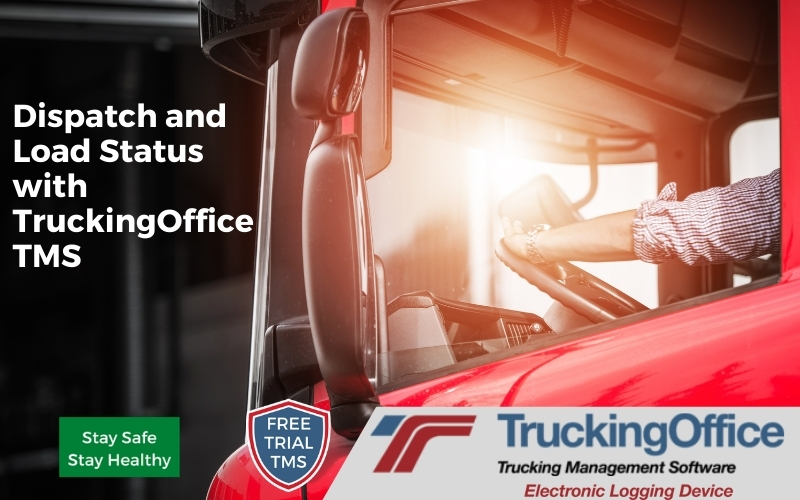Tracking a load doesn’t start when the truck is moving. It starts before the trailer is ever loaded. Dispatch and load status begins when a trucker accepts a load and plans their trip. Most shippers don’t realize that truckers – fleet managers and owner/operators – have to make specific plans to meet their logistics needs. Plenty of truckers do this all by the seat of their pants, and end up with unpaid invoices. How do you manage your trucking business dispatch and load status?
Plan Your Trip: dispatch and load status
It isn’t just LTL that has to plan a load. Any trucker needs basic information before they pull out of the parking lot to go pick up a shipment.
- Who’s the shipper?
- Where is it going?
- Pick up time?
- Delivery date?
- Freight weight/size?
For the solo owner/operator, that may be all they feel they need to accept a load. The dispatch for that trucker is automatic – they’ve agreed to the load and gotten the rest of the information they need. They will create a route using a mapping program and get on the road to arrive at the pick-up location on time. They’ll make sure they have enough hours off the road to be able to drive and deliver.
For a fleet manager, they may also need to consider deadhead miles to get the driver and the truck where the load will be picked up. They have to consider the driver’s HOS.
Dispatch your trip
“Where’s my load?” is at the top of every shipper’s mind. They want to know that their goods are safe, in transit, and getting to the delivery location as they asked.
For the trucker, this is the dispatch – when the truck is moving freight. From the pickup to delivery, the dispatch of the truck finishes when the trailer is empty. Even with LTL shipments, a trip starts with an empty truck and ends when the truck is empty again. What a fleet manager or broker wants to know is what is the status of the load. Is it moving? Where is it? Will it meet the scheduled delivery?
With the power of the Internet, smartphones, and GPS systems, we expect to be able to find a truck’s location easily.
ELD and TMS Together
Finding a load status can be complicated if a trucker is using a load board, but not using a service that reports locations.
Owner/operators and fleet managers need to know where their trucks are. That’s simple. What’s not so simple is how to do it.
Using a system that links the trucking business management system (TMS) and electronic logging devices (ELD) gives the most information to the fleet managers and owner/operators.
Using different systems requires duplicate entries into each. This can lead to some serious problems. If the delivery appointment is entered into one system, but not the other, the driver can be in a lot of trouble. It doesn’t make any sense to have 2 systems when 1 can do it all.
That’s the power of TruckingOffice TMS Pro + ELD.
One system does it all.
When you create a dispatch, you’re also entering the data for the invoice. No need to enter it again into a separate invoicing or accounting program. Save yourself time and be confident that the invoice is accurate.
When you use the ELD to track your equipment, your mileage is tracked for your maintenance records. You’ll be confident that you’re on top of getting your preventative maintenance done to prevent on-the-road emergencies. These records will also protect you in a DOT audit.
Making sure you know your worth – know when to say no to a load. With the number of load boards out there, you’ll probably find loads to haul – but will you know which ones to take? Know your numbers with the TruckingOffice reports that show you where you’re making money and where you’re losing money. Tracking your expenses will indicate where you’re losing money, showing you what to do to increase your profits.
Tracking taxes: whether it’s the quarterly IFTA filing pr the semi-annual IRP, you’ll have the numbers you need from the ELD. No more guessing if you wrote down the mileage when you crossed a state border. No more worrying that you’ll underpay or overpay your taxes.
Want More Info?
We’ve got a video that will give you more information about dispatch and load status using TruckingOffice TMS and ELD together.
Dispatch and load status updates are important, but they’re only small parts of managing your trucking business. You’ve got a lot of numbers to manage to make your business trucking successful. Instead of spending time managing numbers, spend your time making money by moving freight.
Try TruckingOffice TMS and ELD together. You’ll like how it changes your trucking business. We’ll give you a trial of TruckingOffice TMS for free – you can sign up right now. Use it to make your trucking business grow.







Trackbacks/Pingbacks